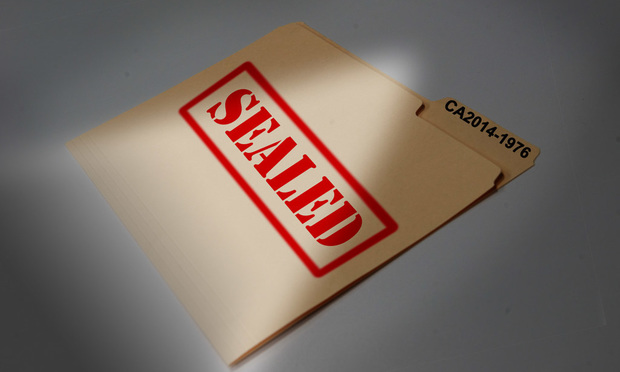Judge's U-Turn on Sealed $2.5M Verdict Highlights Transparency Concerns in the Age of E-Courts
Some lawyers fear judges may be more likely to instinctively seal documents given how easily they can be accessed online.
January 15, 2020 at 12:32 PM
6 minute read
 Photo: Jay Mallin.
Photo: Jay Mallin.
A Middlesex County judge's decision to unseal a $2.5 million verdict was met with approval from legal observers, who aren't ready to criticize him too harshly for his initial decision to seal the verdict.
Lawyers who reviewed Superior Court Judge Thomas Buck's handling of the verdict said the Nov. 8 sealing order was a mistake. But they hailed his Jan. 7 decision to make the verdict public based on a conclusion that the public right to access outweighed any interest of the parties in keeping the amount awarded under wraps.
Although Buck's initial decision to seal the case was made in error, he's unlikely to face any ethics proceeding for that act, according to Marc Garfinkle, a Morristown attorney who represents lawyers and judges in ethics proceedings.
"You can't expect judges to get it right all the time. Here you had a good judge who said 'I might have called this wrong. Let's revisit it,' and was not afraid to do so. For that, I think he's terrific," Garfinkle said.
But some lawyers said baseless orders to seal proceedings and documents appear to be experiencing an uptick. That's thanks to the state judiciary's rollout of e-Courts, said CJ Griffin, co-chair of the New Jersey State Bar Association's Media Law Committee. And the Middlesex judge's decision to seal the $2.5 million verdict highlights the need to improve the system for preventing such orders, said Walter Luers, an Annandale attorney who is president of the New Jersey Foundation for Open Government.
The judge's initial decision to seal the verdict falls in line with a disturbing trend, said Griffin.
"Whenever courts reflexively seal court records or close the courtroom, there is a cause for concern. With the implementation of E-Courts, it seems like there is a trend towards judges being more inclined to reflexively seal documents or dockets, [or] sign overly broad confidentiality orders," Griffin wrote in an email. "The courts need to be very cautious before doing so and instead apply the standards set forth in the court rules and the volumes of case law that discuss the presumption of public access," wrote Griffin, who is with Pashman Stein Walder Hayden in Hackensack.
While New Jersey court records have always been open, the expansion of e-Courts has made it less cumbersome for the public to obtain them without visiting the courthouse, Griffin said.
"My general sense is that in response to that ease of access, more people are in fact accessing court records. And, I have heard anecdotes from clients and reporters who have experienced courts sealing records more reflexively than before, likely because of the knowledge that the documents are easier to access in the online docket now," Griffin wrote.
Luers, likewise, asked if he sensed an increase in sealing motions said, "Yes, my sense is that the number of sealings is increasing, based on my anecdotal experience."
Garfinkle, for his part, saw no such trend. "I have no idea of the frequency of occurrence nor do I suspect there is a problem," he said.
Buck's ultimate decision in favor of public access was met with approval from Luers. But he said the decision draws attention to a weakness in the notion that the public should provide oversight.
"The problem is, in the absence of a judge that wants to do the right thing, this would stay sealed," Luers said. "Unless you are a party in the case, you would not know" that the judge sealed the verdict. "There's no systematic way of learning what's been sealed." he added.
A central registry for sealing orders would make it easier for the public to keep watch over such orders and help prevent them from being entered without cause, Luers said.
The lack of a system for publishing sealed orders gives rise to cases such as Doe v. Hillsborough Township Public School System, a Somerset County case in which a school district is being sued by a former student who claims she was raped repeatedly by a principal. In that case, a broad protective order conceals the case's existence on the docket, preventing the public from tracking the proceedings, he said.
"From the perspective of the public, it doesn't exist. Who knows how many cases there are where the entire docket is sealed," Luers said.
Buck sealed the verdict after conducting a four-week trial in Silva v. Jacobs, which was brought by a worker injured in a construction accident. Counsel for defendant Jacobs Engineering Group sought to have the verdict kept under wraps after it was announced in open court, but a lawyer for plaintiff Joao Silva protested the sealing. Buck said he initially sealed the verdict in order to preserve confidentiality of a high-low agreement between the parties. But his ultimate decision to unseal the verdict was driven by a realization that the interest in confidentiality was outweighed by the presumption of public access.
Buck's initial decision to seal the verdict in order to preserve confidentiality of a high-low deal between the parties doesn't stand up under an examination based on contract law, according to Garfinkle.
"A judge may keep confidential the terms of the high-low agreement, and even suppress any reference to one, while refusing to make confidential the amount of the verdict, which was never subject to the agreement nor mentioned in it," Garfinkle said in an email. "The hi-low agreement says nothing about sealing the verdict—only that the terms of the agreement would not be disclosed. It is clear to me that the verdict may be published without breaching the confidentiality of the 'terms of the agreement' and must be published, barring a good reason for not doing so."
The verdict "remains a public fact, except in extraordinary circumstances, which these are not," Garfinkle wrote.
From the defendant's point of view, the ultimate concern is to hide the amount paid to the plaintiff, according to Garfinkle. "But they never bargained for secrecy of that number, which would have been a neat trick. One may negotiate secrecy into an arm's length agreement, and agree to not reveal a settlement amount, but one may not contractually impose on a court the obligation to seal a jury verdict," Garfinkle said.
This content has been archived. It is available through our partners, LexisNexis® and Bloomberg Law.
To view this content, please continue to their sites.
Not a Lexis Subscriber?
Subscribe Now
Not a Bloomberg Law Subscriber?
Subscribe Now
NOT FOR REPRINT
© 2025 ALM Global, LLC, All Rights Reserved. Request academic re-use from www.copyright.com. All other uses, submit a request to [email protected]. For more information visit Asset & Logo Licensing.
You Might Like
View All
Social Media Policy for Judges Provides Guidance in a Changing World
3 minute read
Bank of America's Cash Sweep Program Attracts New Legal Fire in Class Action
3 minute read
'Something Really Bad Happened': J&J's Talc Bankruptcy Vote Under Attack
7 minute readLaw Firms Mentioned
Trending Stories
- 1Decision of the Day: Trial Court's Sidestep of 'Batson' Deprived Defendant of Challenge to Jury Discrimination
- 2Is Your Law Firm Growing Fast Enough? Scale, Consolidation and Competition
- 3Child Custody: The Dangers of 'Rules of Thumb'
- 4The Spectacle of Rudy Giuliani Returns to the SDNY
- 5Orrick Hires Longtime Weil Partner as New Head of Antitrust Litigation
Who Got The Work
J. Brugh Lower of Gibbons has entered an appearance for industrial equipment supplier Devco Corporation in a pending trademark infringement lawsuit. The suit, accusing the defendant of selling knock-off Graco products, was filed Dec. 18 in New Jersey District Court by Rivkin Radler on behalf of Graco Inc. and Graco Minnesota. The case, assigned to U.S. District Judge Zahid N. Quraishi, is 3:24-cv-11294, Graco Inc. et al v. Devco Corporation.
Who Got The Work
Rebecca Maller-Stein and Kent A. Yalowitz of Arnold & Porter Kaye Scholer have entered their appearances for Hanaco Venture Capital and its executives, Lior Prosor and David Frankel, in a pending securities lawsuit. The action, filed on Dec. 24 in New York Southern District Court by Zell, Aron & Co. on behalf of Goldeneye Advisors, accuses the defendants of negligently and fraudulently managing the plaintiff's $1 million investment. The case, assigned to U.S. District Judge Vernon S. Broderick, is 1:24-cv-09918, Goldeneye Advisors, LLC v. Hanaco Venture Capital, Ltd. et al.
Who Got The Work
Attorneys from A&O Shearman has stepped in as defense counsel for Toronto-Dominion Bank and other defendants in a pending securities class action. The suit, filed Dec. 11 in New York Southern District Court by Bleichmar Fonti & Auld, accuses the defendants of concealing the bank's 'pervasive' deficiencies in regards to its compliance with the Bank Secrecy Act and the quality of its anti-money laundering controls. The case, assigned to U.S. District Judge Arun Subramanian, is 1:24-cv-09445, Gonzalez v. The Toronto-Dominion Bank et al.
Who Got The Work
Crown Castle International, a Pennsylvania company providing shared communications infrastructure, has turned to Luke D. Wolf of Gordon Rees Scully Mansukhani to fend off a pending breach-of-contract lawsuit. The court action, filed Nov. 25 in Michigan Eastern District Court by Hooper Hathaway PC on behalf of The Town Residences LLC, accuses Crown Castle of failing to transfer approximately $30,000 in utility payments from T-Mobile in breach of a roof-top lease and assignment agreement. The case, assigned to U.S. District Judge Susan K. Declercq, is 2:24-cv-13131, The Town Residences LLC v. T-Mobile US, Inc. et al.
Who Got The Work
Wilfred P. Coronato and Daniel M. Schwartz of McCarter & English have stepped in as defense counsel to Electrolux Home Products Inc. in a pending product liability lawsuit. The court action, filed Nov. 26 in New York Eastern District Court by Poulos Lopiccolo PC and Nagel Rice LLP on behalf of David Stern, alleges that the defendant's refrigerators’ drawers and shelving repeatedly break and fall apart within months after purchase. The case, assigned to U.S. District Judge Joan M. Azrack, is 2:24-cv-08204, Stern v. Electrolux Home Products, Inc.
Featured Firms
Law Offices of Gary Martin Hays & Associates, P.C.
(470) 294-1674
Law Offices of Mark E. Salomone
(857) 444-6468
Smith & Hassler
(713) 739-1250







